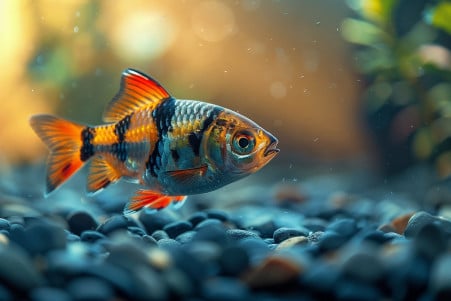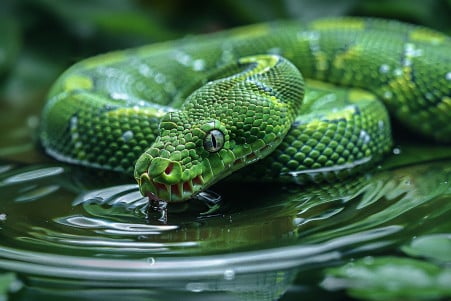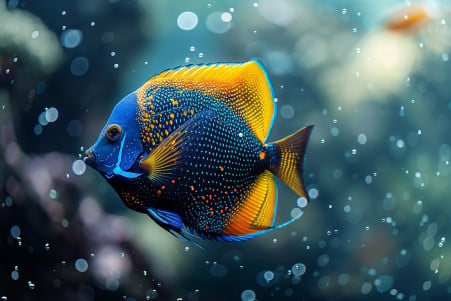Do Fish Drink Water? Exploring Hydration in Aquatic Life
7 February 2024 • Updated 6 February 2024

Humans can simply pour a glass of water to stay hydrated, but how do fish stay hydrated in their underwater environment? Saltwater fish drink seawater to stay hydrated and maintain their salt balance, while also excreting excess salt through their gills and kidneys. Freshwater fish, on the other hand, absorb water osmotically through their skin and gills and therefore don’t have to drink water like saltwater fish.
This article will cover a number of scientific papers from the fields of marine biology, physiology, and ecology that have investigated the interesting ways in which fish stay hydrated. These papers have investigated how fish from different aquatic environments regulate their water intake and internal salt and water balance, and together they offer a comprehensive look at the adaptive strategies fish have developed.
Do fish drink water?
Osmoregulation in Fish
Osmoregulation is the process by which fish regulate their water and salt concentrations, and it is vital for their survival in water.
For example, marine fish live in a dehydrating, salty environment and must drink seawater to maintain their water balance.
A study from the Mt. Desert Island Biological Laboratory demonstrates that marine fish excrete the excess salt they consume through specialized cells in their gills and kidneys.
On the other hand, freshwater fish live in a hypotonic environment, which means the salinity outside their bodies is lower than the salinity inside their bodies. This allows them to passively absorb water through their skin and gills.
A study by Susan L. Edwards shows that freshwater fish actively transport ions to maintain their osmotic balance.
Migratory fish like salmon and trout are an example of fish that have evolved to adapt to different osmotic environments. Salmon and trout are born in freshwater, migrate to the ocean, and then return to freshwater to spawn.
To survive in these different environments, their bodies must undergo significant physiological changes. These changes are facilitated by specialized organs and cells, including ionocytes in gill epithelia, which help regulate ion and water transport.
This is especially important in euryhaline fish, which can live in both freshwater and saltwater, and understanding this process is important for fisheries and aquaculture because it demonstrates the importance of osmotic homeostasis in maintaining fish health and productivity.
Kidney Function in Fish Hydration
The kidneys of fish are responsible for maintaining water and electrolyte balance, and their function is highly dependent on the environment in which the fish live.
In freshwater, the kidneys of fish must work to counteract the constant influx of water by producing large amounts of dilute urine while maintaining a delicate balance of electrolytes by reabsorbing ions.
On the other hand, marine fish must conserve water by producing only small amounts of urine and excreting excess salts, which helps them deal with the dehydrating effects of saltwater. Euryhaline fish, which can live in both freshwater and marine environments, have kidneys that are highly adaptable and can change their excretion patterns to match the demands of their environment, even during life cycle migrations.
A more recent study published in PMC, conducted by Chris M. Wood, has shown that the molecular mechanisms of renal osmoregulation are highly complex and involve the differential expression of specific ion transporters, including Na+, K+-ATPase, and aquaporins in response to changes in salinity.
These results demonstrate the complexity of fish kidney function and show how important it is to understand these processes in aquaculture, where this information could be used to develop better ways of managing fish health in different salinities.
This knowledge is also important for conservation, especially as fish populations are increasingly threatened by climate change and other environmental factors. The interaction between fish behavior and physiological needs is likely to have a major impact on fish well-being, and it demonstrates the complexity of fish hydration.
Behavioral Responses to Drinking Water in Fish
Fish have a number of behavioral responses that help them maintain their hydration levels. For example, marine teleost fish use reflex swallowing to drink seawater and counteract the dehydrating effects of high salinity. Conversely, freshwater fish do not drink water; instead, they take in water osmotically. Euryhaline species also show differences in drinking behavior, with fish drinking more in higher salinity waters, as demonstrated by a study from the University of Hawaiʻi.
These drinking behaviors are regulated by a combination of neural and hormonal systems. Fish have evolved unique ways to control their hydration levels compared to land animals, and the use of reflex swallowing and the importance of the hindbrain in this process are key to this regulation.
In addition, a study from the University of Hawaiʻi found that the hormone prolactin is critical to the regulation of salt and water balance in fish, especially those like the Mozambique tilapia that live in environments with different salinities.
Fish also have a number of fascinating behavioral responses to changes in salinity. For example, proteomic analysis has shown that the estuarine fish Scatophagus argus changes the way it expresses osmoregulatory proteins in response to salinity stress. This behavioral flexibility is important for fish welfare, and understanding it is important for aquaculture so that it can develop methods that take into account the natural ways fish regulate their hydration levels.
Gills: How Fish Stay Hydrated
Gills serve as a multi-purpose organ in fish, with their most important function being osmoregulation. In addition to helping fish breathe, gills also help fish excrete waste like a kidney. This makes gills a key part of both water absorption and ion regulation. As fish move between saltwater and freshwater, their gills help them balance water and salts, which is necessary for their survival.
A study on zebrafish, which was published in PMC, shows how different types of cells in the gills, called ionocytes, help with this. Ionocytes are equipped with ion transporters that help them absorb and release different ions to help the fish maintain its internal balance.
This is also directly impacted by the hormones cortisol and prolactin, which impact ion transport pathways and, as a result, gill function in response to changes in the environment’s salinity.
A study by David H. Evans further highlights the many functions of fish gills, including their role in respiration, osmoregulation, and waste excretion. The complex way that gill function and its control systems collaborate is essential to fish hydration and helps us understand how fish are able to adapt to their environments. This knowledge goes beyond the biological, helping with aquaculture and contributing to conservation.
How Fish Cope With the Dangers of Dehydration
Dehydration poses a serious threat to fish, leading to changes in their physiological condition and overall performance. The risks of dehydration are complicated by the fact that fish tend to regulate their hydration in different ways based on whether they are in marine or freshwater environments.
For example, marine fish that don’t get enough water can disrupt their salt balance, leading to problems with excreting excess salts and potential osmotic stress. On the other hand, freshwater fish may have trouble regulating their ion balance when water levels are low, which can lead to changes in their metabolism and survival.
One of the most thorough reviews of fish dehydration in the PMC by Carciofi et al. looks at the impact of water loss, not only in terms of natural environmental conditions but also in terms of food processing practices like drying.
While dehydration practices are often used intentionally by experts to preserve fish, they draw attention to the physiological responses that occur when fish don’t have enough water. These responses, which include changes in protein conformation and lipid oxidation, can have negative impacts on fish when they happen in their natural environments.
It’s important for fish to maintain the balance of water intake to survive in a variety of aquatic ecosystems. As climate change continues to impact these ecosystems, it’s increasingly important to understand how changes in water availability can threaten fish populations.
Fish will either adapt to or die off because of these changes, which has implications for conservation and the use of aquatic resources. This focus on the impact of environmental changes on aquatic organisms shows that water intake is not just a matter of hydration but a matter of life and death for fish.
The Lateral Line and Beyond: How Fish Sense Their Environment
Fish are highly sensitive to their surroundings, and this sensitivity is essential to their ability to survive and regulate their hydration levels. The lateral line, which is made up of mechanoreceptors called neuromasts, allows fish to detect changes in water pressure and other water qualities.
A study from the University of Bristol, as reported by The Fish Site, shows how this system allows fish to detect changes in water flow, the presence of other fish, and salinity, all of which impact osmoregulatory responses.
In addition to the lateral line, fish have other ways of sensing their environment. For example, research like that from the University of Rhode Island has shown that the lateral line is important for deep-sea dragonfish, suggesting that these fish use non-visual sensory systems to move around in low-light environments. These studies show that sensory systems are important for detecting environmental cues, which will impact fish’s drinking and water intake decisions.
This knowledge also has implications outside of marine biology. As The Fish Site points out, developments in underwater sensor systems can be influenced by the fish lateral line system, leading to advancements in robotics and navigation in murky underwater environments.
This is just one example of how the study of fish sensory systems can lead to bio-inspired design, in which biological principles are used to inform technological innovation. The complex relationship between sensory systems and environmental adaptation shows the adaptability and resourcefulness of fish.
Fish Hydration: An In-Depth Look at Aquatic Adaptations
In this deep dive into fish hydration, we’ve learned about the complex interplay of osmoregulation that allows fish to survive in their watery worlds. Saltwater fish have to deal with the high salinity of the ocean by drinking seawater and then getting rid of the excess salt through special cells.
Freshwater fish don’t drink water at all and instead absorb it directly through their skin and gills. The kidneys of these animals are shown to be highly adaptable to their surroundings, demonstrating an impressive amount of physiological plasticity.
We’ve also seen how fish behavior can show how they’re dealing with their hydration needs, and how their gills are a key site for the regulation of water and ion exchange. The constant need to keep from getting dehydrated shows how adaptable fish are and how important it is to think about the effects of environmental changes, especially in the face of climate change.
The research discussed in this article shows how important it is to keep studying marine biology and physiology. The knowledge that’s gained helps us understand fish better and can also help with conservation and aquaculture. Fish show an incredible ability to change their hydration systems to meet their needs, which helps them survive in changing environments.
In the end, the adaptability of fish in maintaining hydration is an affirmation of the versatility of life. As we learn more about marine science, understanding how these animals maintain their internal water balance is a demonstration of the complexity and interconnection of life on Earth.


